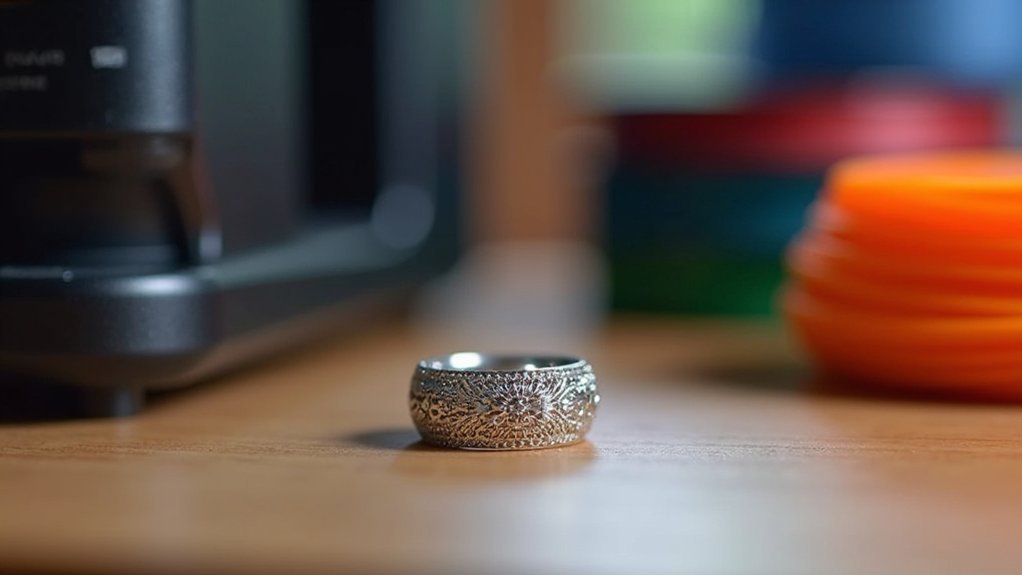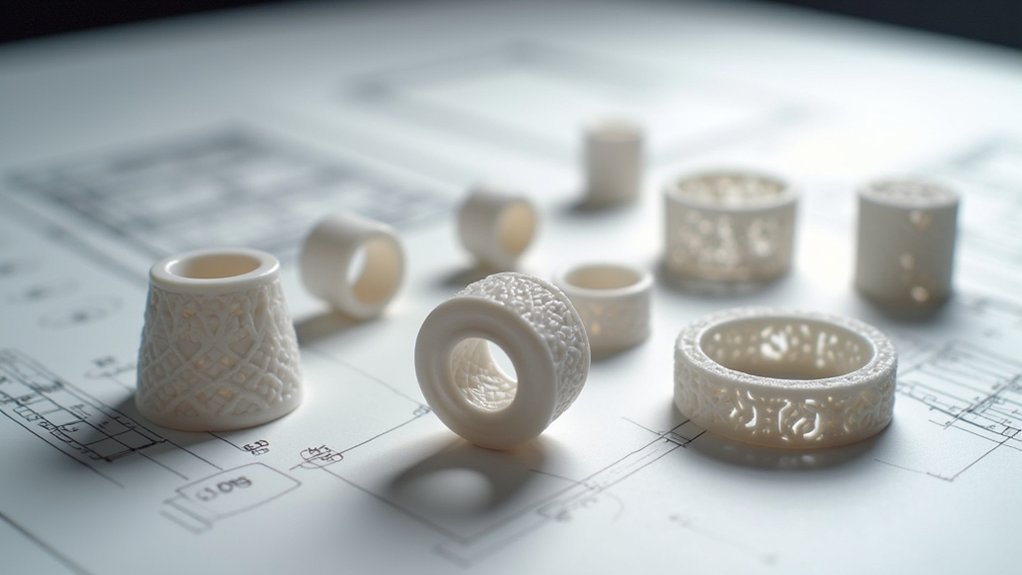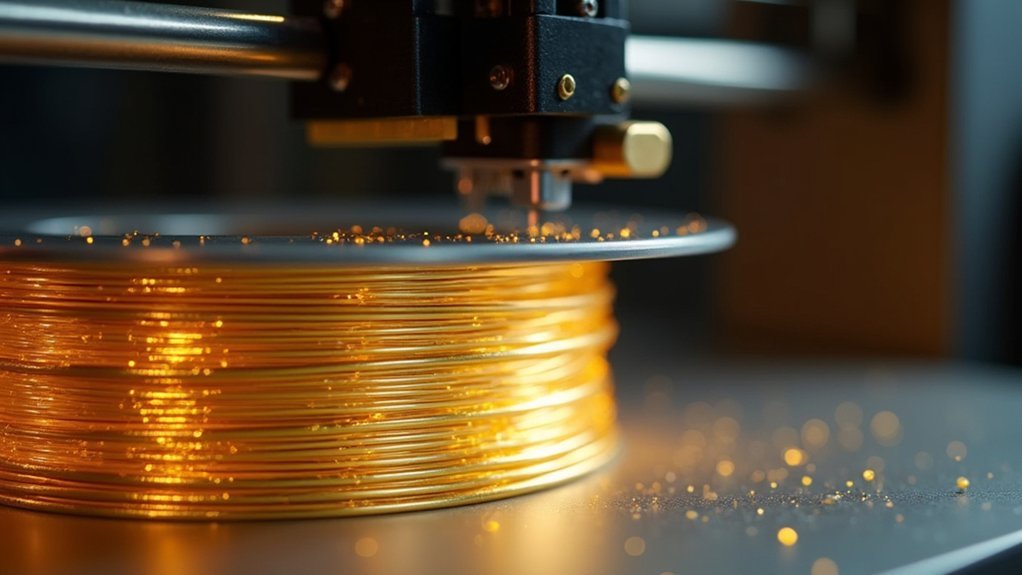You can achieve perfect-fitting jewelry through 3D printing technology that offers unprecedented control over custom sizing with tolerances as tight as ±0.2%. Professional CAD software like Rhino and MatrixGold enables precise measurement adjustments, while flexible measuring tools guarantee accurate digital models. This eliminates costly traditional resizing ($20-$150 per piece) and multiple fitting appointments. Parametric design allows automatic adjustments based on your measurements, reducing material waste through optimized printing. Advanced techniques will transform your jewelry experience completely.
Understanding Size Challenges in Traditional Jewelry Manufacturing

While traditional jewelry manufacturing has served the industry for centuries, you’ll find that standard sizing charts create significant hurdles for achieving proper fit.
When you’re dealing with non-standard body shapes or sizes, these rigid measurements simply don’t accommodate your unique dimensions. You’ll encounter sizing difficulties that lead to uncomfortable pieces that either slip off or feel too tight.
Traditional custom fitting requires multiple appointments and costly adjustments, making the process inefficient for both you and manufacturers.
The rigid materials used in conventional methods limit flexibility for size modifications. Additionally, when manufacturers attempt intricate designs, they often sacrifice comfort for aesthetics since traditional tools lack the precision measures needed to balance both beautiful appearance and proper wearability simultaneously.
How 3D Printing Technology Revolutionizes Custom Sizing
When you embrace 3D printing technology for jewelry creation, you’ll discover unprecedented control over custom sizing that transforms how pieces fit your unique dimensions.
CAD design methods let you adjust measurements precisely and create prototypes before final production, ensuring perfect fits every time.
SLA and DLP technologies deliver accurate results with tolerances as tight as ±0.2%, making them ideal for intricate details in custom-sized pieces.
You can hollow out models during printing to reduce material usage while maintaining structural integrity.
Advanced software tools enable quick design iterations, so you’ll efficiently accommodate unique sizing requests.
This revolutionary approach eliminates traditional manufacturing constraints, giving you complete freedom to create perfectly fitted jewelry that matches each customer’s exact specifications and style preferences.
Essential Tools and Software for Size-Perfect Jewelry Design

To harness the full potential of 3D printing for custom jewelry sizing, you’ll need the right combination of CAD software and specialized tools that deliver precision at every stage of the design process.
Professional CAD platforms like Rhino, SolidWorks, and MatrixGold offer specialized features for intricate detailing and accurate dimension setting. These tools integrate digital ring sizers and size charts, guaranteeing dimensional accuracy from the start.
Professional CAD platforms deliver precision through integrated digital ring sizers and size charts, ensuring dimensional accuracy from initial design to final product.
Your 3D printing software, such as PreForm, provides essential preparation tools including hollowing capabilities and drain hole placement for ideal size and weight control.
Don’t overlook post-processing steps like sanding and polishing, which allow final fit adjustments after printing. This extensive toolkit guarantees your custom jewelry achieves perfect sizing every time.
Measuring Techniques for Accurate Digital Jewelry Sizing
How can you guarantee your 3D-printed jewelry fits perfectly before sending the design to print?
Start with precise measuring techniques using a flexible measuring tape or professional ring sizer tool. These tools provide the foundation for accurate digital jewelry sizing by capturing exact finger circumference and body part dimensions.
Input these measurements directly into your CAD software to create digital models that reflect the intended fit.
Include thorough sizing guides featuring regional measurement standards to help customers determine their correct size.
For custom designs, implement a virtual try-on feature using augmented reality technology, allowing customers to visualize and verify sizing before production.
Continuously refine your sizing templates based on customer feedback to improve accuracy and guarantee consistently well-fitting jewelry pieces.
CAD Design Strategies for Size-Adjustable Jewelry Models

Once you’ve captured accurate measurements, your CAD software becomes the powerhouse for creating jewelry that adapts to multiple sizes without requiring separate models for each dimension.
CAD design strategies for size-adjustable jewelry models center on incorporating flexible joints and expandable mechanisms that maintain design integrity during resizing. You’ll want to implement parametric design techniques that allow dynamic dimension alterations, guaranteeing your rings and bracelets adapt seamlessly to various sizes while preserving aesthetic appeal.
Parametric CAD techniques enable jewelry designs to adapt seamlessly across multiple sizes while maintaining aesthetic integrity and structural performance.
Consider adding modular components that enable segment addition or removal for customizable fits. Hollow structures reduce material usage and allow fine-tuning through wall thickness adjustments.
You should test and iterate your designs continuously, identifying the ideal balance between style and adjustability to guarantee your final product remains both fashionable and functional across different wearers.
Material Selection for Dimensional Accuracy in 3D Printed Jewelry
When selecting materials for 3D printed jewelry, you’re directly influencing the dimensional accuracy of your final pieces. Different materials exhibit varying shrinkage rates during cooling, making material selection critical for achieving precise dimensional tolerances.
| Printing Technologies | Typical Tolerances |
|---|---|
| SLA | ±0.2% |
| DLP | ±0.1 mm |
| FDM Thermoplastics | ±0.3-0.5% |
| Resin-based | ±0.1-0.2% |
Formlabs Rigid 10K Resin stands out for intricate jewelry features, offering exceptional stiffness and precision. Your choice affects both dimensional accuracy and surface finish quality. Softer materials provide design flexibility but may compromise precision. Post-processing techniques like sanding and resin filling can refine dimensions, helping you achieve required tolerances for proper jewelry fit.
Tolerance Management for Perfect Ring and Bracelet Fits

Precision tolerances become the foundation of comfortable jewelry when you’re 3D printing rings and bracelets that must fit perfectly on the human body.
Perfect-fitting 3D printed jewelry demands precision tolerances—the difference between comfortable wearability and disappointing failure lies in millimeter accuracy.
For SLA and DLP technologies, you’ll need ±0.2% tolerances to achieve accurate dimensions. When designing rings, account for band thickness and internal diameter carefully—even ±0.1 mm tolerance variations greatly impact comfort and wearability.
For bracelets, incorporate flexible materials and design adjustability features to accommodate various wrist sizes.
Post-processing techniques like light sanding can refine your fit tolerances and improve surface quality for enhanced comfort. Apply lubricants to multi-part assemblies when needed.
Conduct real part inspections using calibration models to identify dimensional inaccuracies.
This practice guarantees your final printed jewelry adheres to intended design specifications and delivers the perfect fit your customers expect.
Printing Parameters That Impact Final Jewelry Dimensions
While achieving perfect tolerances sets the foundation for comfortable jewelry, the printing parameters you select directly determine whether your final pieces match their intended dimensions.
Your printing technology choice greatly impacts accuracy, with SLA and DLP delivering superior printing tolerances of ±0.2% compared to SLS and FFF at ±0.3% and ±0.5% respectively.
Critical parameters affecting your jewelry’s final size include:
- Layer thickness – Thinner layers provide higher detail and dimensional accuracy, especially in the Z-direction.
- Material selection – Choose materials with known shrinkage properties to compensate for cooling-related dimensional changes.
- Printer calibration – Regular maintenance prevents misalignment issues that compromise accuracy.
Your post-processing decisions also alter final dimensions.
Sanding and polishing can improve surface quality but may reduce overall size, so factor these changes into your initial design specifications.
Post-Processing Techniques for Size Refinement

You’ll need strategic post-processing techniques to achieve the exact dimensions your jewelry designs require.
Start with targeted sanding to remove excess material and create precise fits. Then use resin filling methods like automotive putty to address gaps or imperfections.
These tolerance adjustment strategies let you fine-tune your pieces without reprinting, saving time while ensuring professional results.
Sanding for Precise Fit
After your 3D printer completes its work, sanding becomes your primary tool for achieving that perfect jewelry fit. This essential post-processing technique refines dimensions and eliminates layer lines that could compromise comfort and aesthetics.
Focus your sanding efforts on high-touch areas where smoothness matters most. You’ll want to use a progressive approach for ideal results:
- Start with 200-grit sandpaper to address major imperfections
- Progress to medium grits (400-600) for surface refinement
- Finish with 1000-grit for polished results
Pay special attention to critical areas like ring bands and clasps where precise fit determines wearability.
Maintain consistent technique throughout the process to preserve dimensional accuracy. After completing your sanding work, always re-measure your piece to confirm it meets your intended size specifications.
Resin Filling Methods
Sometimes sanding alone won’t address every dimensional challenge your 3D printed jewelry presents. Resin filling methods offer an effective solution for achieving dimensional accurate results when your printing process creates minor gaps or imperfections. You’ll apply liquid resin strategically to specific areas, then cure it with UV light to create a robust bond with surrounding material.
This technique helps you refine part sizes for better wearability while creating smooth surfaces that enhance visual appeal. The process corrects dimensional inaccuracies that even high-quality resin 3D printers occasionally produce.
| Resin Type | Curing Time | Best Application |
|---|---|---|
| UV Clear | 30-60 seconds | Surface smoothing |
| Flexible | 60-90 seconds | Moving parts |
| High-strength | 90-120 seconds | Structural gaps |
| Colored | 45-75 seconds | Decorative fills |
| Fast-cure | 15-30 seconds | Quick repairs |
Tolerance Adjustment Strategies
While resin filling addresses surface imperfections, tolerance adjustment strategies tackle the broader challenge of achieving precise dimensional accuracy across your entire jewelry piece.
These post-processing techniques guarantee your printed jewelry meets exact specifications for proper mechanical assembly and wearability.
Effective tolerance adjustments require a systematic approach:
- Calibration modeling – Print test pieces before final production to identify and compensate for printer-specific dimensional variations.
- Strategic sanding – Remove material gradually from critical surfaces using progressive grits to achieve target dimensions.
- Precision measurement – Use digital calipers throughout the process to document adjustments and verify dimensional accuracy.
You’ll find that combining automotive putty for filling with UV-cured resin reinforcement creates structurally sound joints while maintaining precise tolerances.
This methodical approach transforms oversized or undersized prints into perfectly fitted jewelry pieces.
Quality Control Methods for Dimensional Verification
Because precision directly impacts the wearability and commercial success of 3D printed jewelry, you’ll need robust quality control methods to verify dimensional accuracy throughout your production process.
Start with regular printer calibration to maintain consistent printing quality and eliminate variations. Use calibration models during print preparation to identify dimensional inaccuracies before full production runs.
Regular printer calibration and test models are essential for catching dimensional errors before committing to full jewelry production runs.
Implement digital calipers as your primary measuring tool for verifying jewelry dimensions against design specifications.
Don’t rely solely on visual inspections—combine them with precise dimensional measurements since minor discrepancies greatly affect fit and wearability.
Optimize your advanced slicing software settings, adjusting layer height and print speed to directly impact final dimensions.
This thorough quality control approach guarantees every piece meets exact specifications for professional results.
Scaling Solutions for Different Body Measurements
You can leverage parametric design customization to automatically adjust jewelry dimensions based on individual measurements, eliminating the guesswork from sizing.
This approach lets you modify key parameters like ring diameter or bracelet circumference within your CAD software, instantly generating perfectly scaled designs.
Multi-size print batches further streamline your workflow by allowing you to produce several size variations simultaneously, giving customers immediate options to test for ideal fit.
Parametric Design Customization
Since traditional jewelry sizing often requires multiple physical fittings and adjustments, parametric design customization offers a revolutionary approach to creating perfectly fitted pieces through digital precision.
You’ll find that CAD software enables automatic dimension adjustments based on your specific measurements, whether you’re ordering a ring or bracelet.
This innovative approach transforms your jewelry shopping experience through:
- Personalized engravings and comfort adjustments that enhance satisfaction
- Reduced material waste by eliminating multiple sizing iterations
- Efficient manufacturing processes that streamline production workflows
When you combine 3D printing technology with parametric design, you’ll benefit from rapid prototyping capabilities.
Jewelers can quickly modify designs and deliver custom-sized pieces that meet your exact specifications, ensuring bespoke jewelry creation happens efficiently and precisely.
Multi-Size Print Batches
When jewelry designers embrace multi-size print batches, they access the ability to produce entire collections of rings, bracelets, and necklaces in various dimensions during a single printing session.
You’ll optimize material usage while reducing waste by scaling designs through CAD software from one master model. 3D printing technologies like SLA and DLP deliver precise tolerances of ±0.2%, ensuring perfect fits across all sizes without sacrificing intricate details.
You can implement hollow designs to lighten weight and reduce printing material costs, making multi-size production economically viable.
This approach enables rapid customization responses to customer demands for personalized fittings and bespoke pieces. You’ll efficiently serve diverse body measurements while maintaining consistent quality standards throughout your entire size range, transforming how you approach jewelry manufacturing.
Troubleshooting Common Size-Related Printing Issues
Although 3D printing technology has advanced considerably, size-related issues remain one of the most frustrating challenges you’ll encounter when creating jewelry.
To make your shot accurate and achieve the level of precision that parts that require exact dimensions need, you must address common problems systematically during the design phase.
Key troubleshooting strategies include:
- Account for material shrinkage – Different materials shrink at varying rates during curing, so factor in material-specific shrinkage percentages when scaling your designs.
- Define precise tolerances – SLA and DLP technologies can achieve ±0.2% accuracy, but you need to specify allowances based on your chosen printing method.
- Test calibration prototypes – Print test models before final production to identify dimensional issues and verify customer fit specifications.
Cost-Effective Approaches to Custom Sizing Solutions
While traditional jewelry resizing can cost anywhere from $20 to $150 per piece, 3D printing transforms custom sizing into a streamlined, budget-friendly process that puts control directly in your hands.
You’ll create custom-sized jewelry using CAD software to modify existing designs without significant additional costs, making bespoke solutions accessible to everyone.
Hollowing out your 3D printing models saves material while maintaining intricate details, helping you reduce production costs substantially.
You can print multiple sizes in single batches, eliminating expensive molds and manual adjustments.
Design adjustable components or interlocking parts to provide versatile sizing options that accommodate finger size changes over time, maximizing your jewelry’s longevity and value.
Future Innovations in 3D Printed Jewelry Fit Technology
As 3D printing technology evolves at breakneck speed, revolutionary innovations are reshaping how perfectly fitted jewelry becomes reality for every wearer.
Machine learning algorithms now analyze your preferences and fit feedback, enabling real-time design adjustments that capture fine details and engineering fits with unprecedented precision. These smart systems learn from each interaction, continuously improving their ability to create complex shapes that conform perfectly to your unique anatomy.
Future developments promise even more exciting possibilities:
- Self-adjusting mechanisms that automatically adapt to temperature changes and body fluctuations throughout the day
- Advanced flexible 3D printing materials like TPU that provide superior comfort and durability
- Parametric design integration allowing instant size modifications across different body types
You’ll soon experience jewelry that doesn’t just fit—it intelligently responds to your body’s needs.
Frequently Asked Questions
How Do I Reduce Shrinkage in 3D Printing?
You’ll reduce shrinkage by choosing materials with lower shrinkage rates, printing slower at higher temperatures, calibrating your printer properly, adding design fillets, and post-processing with annealing or UV curing techniques.
Can You Print Jewelry With a 3D Printer?
You can print jewelry with a 3D printer using SLA or DLP technologies. You’ll achieve high detail and accuracy for intricate designs, create custom pieces, and produce lightweight hollow structures using specialized resins.
How to 3D Print Something That Is Too Big?
Split your model into smaller sections using CAD software, then print each piece separately. Use alignment features or straight cuts with identifiers for easy assembly, bonding parts with epoxy or cyanoacrylate adhesive.
What Is the Tolerance for a Snug Fit 3D Print?
You’ll need tolerances of ±0.1 mm to ±0.2 mm for a snug fit in 3D printing. This range guarantees proper alignment without excessive force while accounting for material shrinkage and printer variations during manufacturing.
In Summary
You’ve discovered how 3D printing transforms jewelry sizing from guesswork to precision. You can now create perfectly fitted pieces using digital measurements, CAD strategies, and scaling solutions. Don’t let traditional manufacturing limitations hold you back—embrace these innovative technologies to deliver custom jewelry that fits flawlessly every time. Your customers will appreciate the comfort and quality that comes with truly personalized sizing solutions.




Leave a Reply